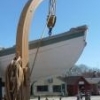-
Posts
1,867 -
Joined
-
Last visited
Reputation Activity
-
 Chuck Seiler got a reaction from CharlieZardoz in How much detail is too much
Chuck Seiler got a reaction from CharlieZardoz in How much detail is too much
All good points. I think that the better you get, the more detail you can put into your model. One reason for this is because you are getting better and can do things quicker. If it takes you forever to do the basic stuff, it will take several forevers to make it detailed. Secondly, when you get better your quality improves. Crappy details don't improve crappy models (trust me on that one). However when you have a quality model, quality details improve it.
That having been said, there IS such thing as too much detail. I think scale dictates that. Sometimes you can overwhelm a model with too much detail. Personal preference. Take a step back and let the model tell you what is right.
Who is your audience? If you are doing if for just yourself, make it for you. If you are making it for the public to see, remember people will only look at it for a few minutes, then go away. Some will look for 30 seconds some for 10 minutes. Make your model so it appeals to all of them in its own way.
...and whatever level of detail you decide upon, make ONE thing significantly more detailed. People will focus on that, you will get your "Holy Cow!!!" and people will walk away with a feeling it is far more detailed than it really is, because of the one they fixated on.
-
 Chuck Seiler got a reaction from EJ_L in How much detail is too much
Chuck Seiler got a reaction from EJ_L in How much detail is too much
All good points. I think that the better you get, the more detail you can put into your model. One reason for this is because you are getting better and can do things quicker. If it takes you forever to do the basic stuff, it will take several forevers to make it detailed. Secondly, when you get better your quality improves. Crappy details don't improve crappy models (trust me on that one). However when you have a quality model, quality details improve it.
That having been said, there IS such thing as too much detail. I think scale dictates that. Sometimes you can overwhelm a model with too much detail. Personal preference. Take a step back and let the model tell you what is right.
Who is your audience? If you are doing if for just yourself, make it for you. If you are making it for the public to see, remember people will only look at it for a few minutes, then go away. Some will look for 30 seconds some for 10 minutes. Make your model so it appeals to all of them in its own way.
...and whatever level of detail you decide upon, make ONE thing significantly more detailed. People will focus on that, you will get your "Holy Cow!!!" and people will walk away with a feeling it is far more detailed than it really is, because of the one they fixated on.
-
 Chuck Seiler got a reaction from Cathead in How much detail is too much
Chuck Seiler got a reaction from Cathead in How much detail is too much
All good points. I think that the better you get, the more detail you can put into your model. One reason for this is because you are getting better and can do things quicker. If it takes you forever to do the basic stuff, it will take several forevers to make it detailed. Secondly, when you get better your quality improves. Crappy details don't improve crappy models (trust me on that one). However when you have a quality model, quality details improve it.
That having been said, there IS such thing as too much detail. I think scale dictates that. Sometimes you can overwhelm a model with too much detail. Personal preference. Take a step back and let the model tell you what is right.
Who is your audience? If you are doing if for just yourself, make it for you. If you are making it for the public to see, remember people will only look at it for a few minutes, then go away. Some will look for 30 seconds some for 10 minutes. Make your model so it appeals to all of them in its own way.
...and whatever level of detail you decide upon, make ONE thing significantly more detailed. People will focus on that, you will get your "Holy Cow!!!" and people will walk away with a feeling it is far more detailed than it really is, because of the one they fixated on.
-
 Chuck Seiler got a reaction from Landlubber Mike in How much detail is too much
Chuck Seiler got a reaction from Landlubber Mike in How much detail is too much
All good points. I think that the better you get, the more detail you can put into your model. One reason for this is because you are getting better and can do things quicker. If it takes you forever to do the basic stuff, it will take several forevers to make it detailed. Secondly, when you get better your quality improves. Crappy details don't improve crappy models (trust me on that one). However when you have a quality model, quality details improve it.
That having been said, there IS such thing as too much detail. I think scale dictates that. Sometimes you can overwhelm a model with too much detail. Personal preference. Take a step back and let the model tell you what is right.
Who is your audience? If you are doing if for just yourself, make it for you. If you are making it for the public to see, remember people will only look at it for a few minutes, then go away. Some will look for 30 seconds some for 10 minutes. Make your model so it appeals to all of them in its own way.
...and whatever level of detail you decide upon, make ONE thing significantly more detailed. People will focus on that, you will get your "Holy Cow!!!" and people will walk away with a feeling it is far more detailed than it really is, because of the one they fixated on.
-
 Chuck Seiler got a reaction from tarbrush in How much detail is too much
Chuck Seiler got a reaction from tarbrush in How much detail is too much
All good points. I think that the better you get, the more detail you can put into your model. One reason for this is because you are getting better and can do things quicker. If it takes you forever to do the basic stuff, it will take several forevers to make it detailed. Secondly, when you get better your quality improves. Crappy details don't improve crappy models (trust me on that one). However when you have a quality model, quality details improve it.
That having been said, there IS such thing as too much detail. I think scale dictates that. Sometimes you can overwhelm a model with too much detail. Personal preference. Take a step back and let the model tell you what is right.
Who is your audience? If you are doing if for just yourself, make it for you. If you are making it for the public to see, remember people will only look at it for a few minutes, then go away. Some will look for 30 seconds some for 10 minutes. Make your model so it appeals to all of them in its own way.
...and whatever level of detail you decide upon, make ONE thing significantly more detailed. People will focus on that, you will get your "Holy Cow!!!" and people will walk away with a feeling it is far more detailed than it really is, because of the one they fixated on.
-
 Chuck Seiler reacted to Modeler12 in How much detail is too much
Chuck Seiler reacted to Modeler12 in How much detail is too much
Chuck's point is well taken. First of all, though, is you. What do you think will be the main features you like? If it sails you want, be ready for a lot of work. If the cannons are very important as a 'whow', then concentrate on those more.
I personally liked doing the rigging with lots of details on the various lines that operate the ship. I not only learned what they were all about, but it was a challenge to put them all together (with mistakes and several re-does).
Then when it came to doing both sides of the ship the same, I 'cheated' because I was going to have the ship against a wall. So I used that side to 'experiment'. That was for the hull as well as those lines not too visible from the front view.
To give you an idea of what the sails on my USS Constitution took to make, here is a picture of one of those topsails and all the lines that go with it.
-
 Chuck Seiler got a reaction from Landlocked123 in How much detail is too much
Chuck Seiler got a reaction from Landlocked123 in How much detail is too much
All good points. I think that the better you get, the more detail you can put into your model. One reason for this is because you are getting better and can do things quicker. If it takes you forever to do the basic stuff, it will take several forevers to make it detailed. Secondly, when you get better your quality improves. Crappy details don't improve crappy models (trust me on that one). However when you have a quality model, quality details improve it.
That having been said, there IS such thing as too much detail. I think scale dictates that. Sometimes you can overwhelm a model with too much detail. Personal preference. Take a step back and let the model tell you what is right.
Who is your audience? If you are doing if for just yourself, make it for you. If you are making it for the public to see, remember people will only look at it for a few minutes, then go away. Some will look for 30 seconds some for 10 minutes. Make your model so it appeals to all of them in its own way.
...and whatever level of detail you decide upon, make ONE thing significantly more detailed. People will focus on that, you will get your "Holy Cow!!!" and people will walk away with a feeling it is far more detailed than it really is, because of the one they fixated on.
-
 Chuck Seiler got a reaction from Canute in How much detail is too much
Chuck Seiler got a reaction from Canute in How much detail is too much
All good points. I think that the better you get, the more detail you can put into your model. One reason for this is because you are getting better and can do things quicker. If it takes you forever to do the basic stuff, it will take several forevers to make it detailed. Secondly, when you get better your quality improves. Crappy details don't improve crappy models (trust me on that one). However when you have a quality model, quality details improve it.
That having been said, there IS such thing as too much detail. I think scale dictates that. Sometimes you can overwhelm a model with too much detail. Personal preference. Take a step back and let the model tell you what is right.
Who is your audience? If you are doing if for just yourself, make it for you. If you are making it for the public to see, remember people will only look at it for a few minutes, then go away. Some will look for 30 seconds some for 10 minutes. Make your model so it appeals to all of them in its own way.
...and whatever level of detail you decide upon, make ONE thing significantly more detailed. People will focus on that, you will get your "Holy Cow!!!" and people will walk away with a feeling it is far more detailed than it really is, because of the one they fixated on.
-
 Chuck Seiler got a reaction from captainbob in How much detail is too much
Chuck Seiler got a reaction from captainbob in How much detail is too much
All good points. I think that the better you get, the more detail you can put into your model. One reason for this is because you are getting better and can do things quicker. If it takes you forever to do the basic stuff, it will take several forevers to make it detailed. Secondly, when you get better your quality improves. Crappy details don't improve crappy models (trust me on that one). However when you have a quality model, quality details improve it.
That having been said, there IS such thing as too much detail. I think scale dictates that. Sometimes you can overwhelm a model with too much detail. Personal preference. Take a step back and let the model tell you what is right.
Who is your audience? If you are doing if for just yourself, make it for you. If you are making it for the public to see, remember people will only look at it for a few minutes, then go away. Some will look for 30 seconds some for 10 minutes. Make your model so it appeals to all of them in its own way.
...and whatever level of detail you decide upon, make ONE thing significantly more detailed. People will focus on that, you will get your "Holy Cow!!!" and people will walk away with a feeling it is far more detailed than it really is, because of the one they fixated on.
-
 Chuck Seiler got a reaction from GuntherMT in Continental Gunboat PHILADELPHIA by Chuck Seiler - Model Shipways - 1:24 Scale - Enhanced
Chuck Seiler got a reaction from GuntherMT in Continental Gunboat PHILADELPHIA by Chuck Seiler - Model Shipways - 1:24 Scale - Enhanced
The Smithsonian 3D scan is of the ship as it is now. That includes all deterioration. Notice the gaps in the planking. .
Above is a picture of Dave Yotter's PHILADELPHIA (taken from our recent ship model Guild meeting) built from the Smithsonian plans. Note how the curve of the caprail trends upward until it abruptly ends. That's where it was chopped off. You can that, if left in place, the operation of the forward gun would be impaired.
Unlike the Model Expo plans, the Smithsonian plans are structurally correct. If you blow up the pic, you can see that the gap is indeed open and you can see into the innards. Kurt's replication is about the same. As previously discussed, they were not too concerned about water getting in there and rotting the insides out. They knew it would not be afloat long enough to worry about.
-
 Chuck Seiler got a reaction from FredSC in How much detail is too much
Chuck Seiler got a reaction from FredSC in How much detail is too much
All good points. I think that the better you get, the more detail you can put into your model. One reason for this is because you are getting better and can do things quicker. If it takes you forever to do the basic stuff, it will take several forevers to make it detailed. Secondly, when you get better your quality improves. Crappy details don't improve crappy models (trust me on that one). However when you have a quality model, quality details improve it.
That having been said, there IS such thing as too much detail. I think scale dictates that. Sometimes you can overwhelm a model with too much detail. Personal preference. Take a step back and let the model tell you what is right.
Who is your audience? If you are doing if for just yourself, make it for you. If you are making it for the public to see, remember people will only look at it for a few minutes, then go away. Some will look for 30 seconds some for 10 minutes. Make your model so it appeals to all of them in its own way.
...and whatever level of detail you decide upon, make ONE thing significantly more detailed. People will focus on that, you will get your "Holy Cow!!!" and people will walk away with a feeling it is far more detailed than it really is, because of the one they fixated on.
-
 Chuck Seiler got a reaction from popeye the sailor in How much detail is too much
Chuck Seiler got a reaction from popeye the sailor in How much detail is too much
All good points. I think that the better you get, the more detail you can put into your model. One reason for this is because you are getting better and can do things quicker. If it takes you forever to do the basic stuff, it will take several forevers to make it detailed. Secondly, when you get better your quality improves. Crappy details don't improve crappy models (trust me on that one). However when you have a quality model, quality details improve it.
That having been said, there IS such thing as too much detail. I think scale dictates that. Sometimes you can overwhelm a model with too much detail. Personal preference. Take a step back and let the model tell you what is right.
Who is your audience? If you are doing if for just yourself, make it for you. If you are making it for the public to see, remember people will only look at it for a few minutes, then go away. Some will look for 30 seconds some for 10 minutes. Make your model so it appeals to all of them in its own way.
...and whatever level of detail you decide upon, make ONE thing significantly more detailed. People will focus on that, you will get your "Holy Cow!!!" and people will walk away with a feeling it is far more detailed than it really is, because of the one they fixated on.
-
 Chuck Seiler got a reaction from janos in How much detail is too much
Chuck Seiler got a reaction from janos in How much detail is too much
All good points. I think that the better you get, the more detail you can put into your model. One reason for this is because you are getting better and can do things quicker. If it takes you forever to do the basic stuff, it will take several forevers to make it detailed. Secondly, when you get better your quality improves. Crappy details don't improve crappy models (trust me on that one). However when you have a quality model, quality details improve it.
That having been said, there IS such thing as too much detail. I think scale dictates that. Sometimes you can overwhelm a model with too much detail. Personal preference. Take a step back and let the model tell you what is right.
Who is your audience? If you are doing if for just yourself, make it for you. If you are making it for the public to see, remember people will only look at it for a few minutes, then go away. Some will look for 30 seconds some for 10 minutes. Make your model so it appeals to all of them in its own way.
...and whatever level of detail you decide upon, make ONE thing significantly more detailed. People will focus on that, you will get your "Holy Cow!!!" and people will walk away with a feeling it is far more detailed than it really is, because of the one they fixated on.
-
 Chuck Seiler got a reaction from Ryland Craze in Continental Gunboat PHILADELPHIA by Chuck Seiler - Model Shipways - 1:24 Scale - Enhanced
Chuck Seiler got a reaction from Ryland Craze in Continental Gunboat PHILADELPHIA by Chuck Seiler - Model Shipways - 1:24 Scale - Enhanced
The Smithsonian 3D scan is of the ship as it is now. That includes all deterioration. Notice the gaps in the planking. .
Above is a picture of Dave Yotter's PHILADELPHIA (taken from our recent ship model Guild meeting) built from the Smithsonian plans. Note how the curve of the caprail trends upward until it abruptly ends. That's where it was chopped off. You can that, if left in place, the operation of the forward gun would be impaired.
Unlike the Model Expo plans, the Smithsonian plans are structurally correct. If you blow up the pic, you can see that the gap is indeed open and you can see into the innards. Kurt's replication is about the same. As previously discussed, they were not too concerned about water getting in there and rotting the insides out. They knew it would not be afloat long enough to worry about.
-
 Chuck Seiler reacted to jbshan in 74 Gun Ship Complete Framing Supplemental Plans
Chuck Seiler reacted to jbshan in 74 Gun Ship Complete Framing Supplemental Plans
A two-car garage ought to be big enough to still be able to have something in build after you have this one on display. You don't want to be cramped. Do be careful going back and forth between plans sets. The books (4 vol. set) are in French feet, as I understand it.
-
 Chuck Seiler got a reaction from Landlubber Mike in 74 Gun Ship Complete Framing Supplemental Plans
Chuck Seiler got a reaction from Landlubber Mike in 74 Gun Ship Complete Framing Supplemental Plans
Which project do you start first? The model or the room addition used to store the model?
-
 Chuck Seiler got a reaction from garywatt in GUNBOAT PHILADELPHIA by Steve.Y - FINISHED - Model Shipways
Chuck Seiler got a reaction from garywatt in GUNBOAT PHILADELPHIA by Steve.Y - FINISHED - Model Shipways
Steve,
There is nothing wrong with taking your time and making sure everything is correct. It will save alot of time and grief down the road. Looking good.
-
 Chuck Seiler reacted to chborgm in Continental Gunboat PHILADELPHIA by Chuck Seiler - Model Shipways - 1:24 Scale - Enhanced
Chuck Seiler reacted to chborgm in Continental Gunboat PHILADELPHIA by Chuck Seiler - Model Shipways - 1:24 Scale - Enhanced
Chuck
In the kit there is a gap at the bow where the caps stop about a half inch from the bow. this leaves the frame and inards exposed. How did you handle this.
Clarence
-
 Chuck Seiler reacted to Pete Jaquith in Brig Fair American circa 1780 by Pete Jaquith - Model Shipways - 1:48 scale
Chuck Seiler reacted to Pete Jaquith in Brig Fair American circa 1780 by Pete Jaquith - Model Shipways - 1:48 scale
wq3296,
The doors on my model are ~4' 6" high as I have modified the bulwark and quarter deck heights. Tight, but with a step down under the quarter deck it would be consistant with period practice.
Regards,
Pete
-
 Chuck Seiler reacted to KenW in Rattlesnake by KenW - FINISHED - Model Shipways - Scale 1:64 - American Privateer
Chuck Seiler reacted to KenW in Rattlesnake by KenW - FINISHED - Model Shipways - Scale 1:64 - American Privateer
I completed the horizontal framing of the gun ports. And I think the line of the lower sills looks good. The top of the upper sills aren’t sanded yet and the insides are not faired. And, I may still make some modifications once the vertical frames are added. The wood I used is redheart since my son doesn’t want me to use any paint on the model. The color isn’t bad; although my working space is getting a red hue to it. Again the wood from Crown Timberyard is excellent.
-
 Chuck Seiler reacted to KenW in Rattlesnake by KenW - FINISHED - Model Shipways - Scale 1:64 - American Privateer
Chuck Seiler reacted to KenW in Rattlesnake by KenW - FINISHED - Model Shipways - Scale 1:64 - American Privateer
I’m ready to start planking above the wales, but the order of boxwood I made specified the wrong size. So I have to wait for a new shipment.
While waiting, I decided to work on some deck furniture – first up is the binnacle. I didn’t like the dye-cast metal binnacle provided by MS on the Fair American, and the one provided with the Rattlesnake is no better.
So, again, I made my own from scratch. I tried to model it after the one shown on Plate 1 of the Hann plans. I added a smoke stack as seen on the Campbell plan because I like its look. Next I will attempt the pumps.
-
 Chuck Seiler reacted to Cathead in Bertrand by Cathead - FINISHED - 1:87 - wooden Missouri River sternwheeler
Chuck Seiler reacted to Cathead in Bertrand by Cathead - FINISHED - 1:87 - wooden Missouri River sternwheeler
The hulls of western river boats are quite different from those of ocean-going ships, and this presents the first challenge of this project. For example, the Bertrand has no keel, meaning I will have to work out a new way to lay out the hull’s framing without an external keel to anchor everything on.
There are good reasons for this oddity. While early river boats were built like regular ships, with projecting keeps and deep hulls, it was quickly determined that this didn’t work on the shallow, fast-flowing, curvaceous rivers of the region, for several reasons:
1) Keels provide resistance against leeway. This was not only unnecessary for steam-powered boats, it was actually a detriment to the maneuverability needed to handle the sharp turns and shifting currents of the rivers. Riverboats were amazingly nimble, and large keels just got in the way.
2) Keels strengthen the hull longitudinally. This, too, quickly proved to be a detriment under western river conditions. While the long, narrow hulls of steamboats were very prone to hogging, they also needed to be flexible for the inevitable need to scrape over sandbars or even rock shoals. It has been claimed that steamboat hulls needed to flex two feet vertically to handle the river conditions they were subjected to; an overly strong keel could break the back of a steamboat like a ship on a reef, rather than allowing it to slither over shoals. We’ll explore the steamboat designers’ flexible solution to hogging later in the project.
3) Deep hulls provide stability and cargo capacity, but shallow channels made this impossible. Steamboats quickly evolved to barge-like hulls carrying all their machinery and most of their cargo on the deck; their long, flat-bottomed hulls provided all the buoyancy they needed. The Bertrand was only about 14 feet shorter than USS Constitution at the waterline, and almost as wide on deck, but with about 10% of the draft and displacement. Bertrand would have lasted mere minutes in the open sea, but Old Ironsides couldn't have made it thousands of miles upriver to western Montana carrying tons of cargo.
None of this would matter much for the model if I intended to simply plank the hull; in that case I would either cut bulkheads or shape a solid block, and just plank over everything. But I want to show off the unique internal framing of the craft, and so have to work out the best way to assemble it in place.
The Bertrand has something like 60-70 internal frames, including some cant frames in the stem. Above, you see examples of a typical midsection frame. These aren't curved the way a ship’s are, just a straight floor joined to two straight futtocks at an angle. There were multiple ways to make this joint; on the Bertrand this was a cocked-hat chine in which the two pieces were simply butted together at the turn of the bilge and braced with a triangular timber. I will need to make about 40 of these assemblies, plus 20-30 more that slowly change shape with the curve of the bow and stern.
You’ll notice that my frames are a bit thicker than the scale plans imply. This is intentional, as I feel that truly scale timbers would be extremely difficult to work with. They need to be strong enough to hold their shape against fairing and handling, and I don’t think would have enough surface area to hold glue joints properly in some of the unusual arrangements I’ll need to do. This is especially true as I intend to leave a large section unplanked, such that the frames need to hold their own. When the model is completed, I don’t think the slightly overscale timbers will be noticeable, but the model will be much stronger.
I made these by first cutting an internal wooden pattern to the exact shape of the mid-hull, as taken from the plans. The pattern is from slightly thinner stock than the frames. I then cut and lay out the three pieces, with a small dab of wood glue in the two joints, with the pattern holding them to shape. When the glue is tacky, only a few minutes, I spread more on top of the joint and lay two broader pieces at an angle across the joint to create the “cocked hat” brace (this is why the pattern needs to be thinner, so it doesn’t get glued to the brace). When the assembly is dry, I use a sharp knife to carve away the excess, including the plank-width area at the outside turn of the bilge. One broad plank will be used here between the side planking and the bottom planking, as on the prototype. While it might seem that making 40+ of these would take forever, each one takes only a few minutes. I simply make one, set it aside, and work on something else. Doing this in the background means I’ll have them all done by the time I work out the rest of the hull plan.
As for how to assemble all these, my current plan is to make a building board with parallel grooves at the spacing & depth of the hull frames. I can then set all the frames into this pattern while attaching them as on the prototype, with a variety of internal stringers and a strong keelson. This, incidentally, is another reason to use my slightly over-sized stock: it’s the same width as my table saw’s dado, making this process very convenient.
In the next installment, I’ll explore the bow area, and how I plan to tackle the framing in that area. In the meantime, I’ll be making a lot of hull frames! In the meantime, any comments, questions, and suggestions are quite welcome.
-
 Chuck Seiler reacted to tkay11 in 18th and early 19th Century cutter models
Chuck Seiler reacted to tkay11 in 18th and early 19th Century cutter models
Cutter; 12 Guns. Object ID SLR0704.
The description provided on the NMM web site is: "Scale: probably 1:72. A contemporary (?) plank on frame full hull model of a 12-gun cutter. The fact that the hull is planked in carvel fashion, (edge to edge planking), and that a square topsail is rigged would suggest a date of about 1820. Also the decoration on the stern indicates the name ‘Pelican’ although a cutter of this name cannot be traced either as a man-of-war or a revenue cruiser".
The interesting thing here (for me, at least!) is that again the belaying rack at the bow is running fore-aft by the bowsprit.
Tony
-
 Chuck Seiler reacted to tkay11 in 18th and early 19th Century cutter models
Chuck Seiler reacted to tkay11 in 18th and early 19th Century cutter models
Smokey Joe, Object ID SLR2631
The next one I saw is an unarmed cutter, probably acting as a pilot cutter. Its standard of construction is not as good as the others, but there are interesting details. Its name, Smokey Joe, is thought by the Museum to be fictitious, although very appropriate given the appearance of the model.
Tony
-
 Chuck Seiler reacted to tkay11 in 18th and early 19th Century cutter models
Chuck Seiler reacted to tkay11 in 18th and early 19th Century cutter models
Trial 1790, Object ID SLR0150Next was a model I had previously seen on display at the NMM in Greenwich. Its name probably refers to the fact that it had an experimental sliding keel. It is really beautifully constructed, but Nick said that it might have had some re-working at the museum.
Its original caption at the NMM stated:
The other photos really just show the beauty and detail of the construction
Tony














